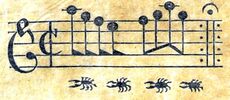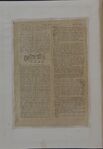“Veritable and Singular Account of an Apparition, and the Saving of a Soul, in Castle Weixelstein, in Krain.”
I send you one of the best ghost-stories, and one which your readers have certainly never seen. We were lately paying a visit to the Castle of Weixelstein, near Steinbrucke, Krain (Carniola), the country house of our hospitable friends Mons, and Madame Gutmansthal Senvenuti. My attention was drawn to two old and portly folios, entitled Die Ehre des Herzogthum’s Krain (the “Honour of the Dutchy of Carniola”). An awful title-page of forty-six lines declares that it was written by Johann Weichard, Freiherr (Baron) Valvasor, or Walvasor, Lord of Wazenberg, and printed at Laibach in M.DC.LXXXIX.

The author, a Fellow R. Soc., London, who was Governor of the Dutchy and Captain of the Frontier, then an important post, is portrayed with long hair, a la Milton, shaven face, and laced cravat (Croatian) falling over his breastplate. The book is full of curious episodes, and above I give you the “time” it recommends for catching crabs. Amongst other things it gives a valuable disquisition on the bile (lib. xi.), which it dates from the days of Saint Jerome (a.d. 400). Volume I., which is historical, contains 836 pages (lib. i.—viii.): Volume II. 1007 (lib. ix.— xv.), besides the Register (appendix, index, etc.). It is profusely illustrated by the author’s hand with maps and plans, genealogies and coats of arms, scenery and castles, costumes and portraits; and, lastly, with representations of battles, sieges, hangings, roastings, and hurlings headlong from rocks. The tail-piece is a duello between a Christian man-at-arms and a “turban’d Turk.” The plates are on metal, and remarkably good. Anew’ edition of this noble old historico-topo-graphical monograph is now being issued from Laibach (Labacus). “Carniolia antiqua et nova,” is happy in her Memoirs. Valvasor has a rival-in Johann Ludovicus Schowleben, whose folio appeared Labaci M.DC.LXXXI., (Emonie seuLabaci Conditio, MM.DCCC.IV. Of the latter, however, only the Tomus Primus, ending about a.d. 1000, appeared: the Secundus was not printed, and the fate of the manuscript is unknown.
Valvasor gives a view of Castle Weixelstein, “Cherry-tree Rock,” which the Slavs call Novi Dvor (New Court). There is some change in the building since 1689. The square towers at the angles appear lower, from the body of the house having been raised. The Hof, or hollow court to the south, has been surrounded by a second story; and the fine linden-tree in the centre is a stump, bearing a large flower-pot. The scene of the apparition is a low room with barred windows and single-arched ceiling, which is entered by the kitchen, the first door to the right of the main gate. The old families mentioned in the story have mostly disappeared. Enough of preliminary.
The following is a literal translation of Valvasor’s old German:—
“At the castle above-named strange noises (rumor) were heard during the night for several years; but the origin of the same was a subject of (vain) research and speculation. After a time a new servant wench (mensch) engaged in the house, whose name was Ankha (i.e., Anna) Wnikhlaukha, had the courage, on hearing these mysterious sounds, to address the ghost in the following manner:
“The 15th of January, a.d. 1684.—Firstly, at night a noise arose in the servant-wenches’ room, as though someone were walking about clad in iron armour and clanking chains. The women being sorely frightened, some stable-hands were brought to sleep with them. They were struck upon the head, and one was like to die of terror.
“The 16th of January.—In the evening, as the lights still burnt, a rapping was heard at the room door; but when they went to see what caused it, nothing was found. Presently those inside put out the lamps, and lay down to rest. Thereupon began a loud clatter; the two servant wenches, Marinkha (Marian) Samanouklia and Miza (Mitza, Mary) Sayeschankha were seized by the head, but they could distinguish no one near them.”
The whole account is strictly “spiritualistic.” Ankha is the chosen medium, and nothing is done till she appears on the scene. The ghost will hardly answer the officious and garrulous steward; and has apparently scant respect for the reverend men who are called in. One of the latter somewhat justified the ghost’s disdain by telling a decided “fib.” The steps by which the apparition changes from hot to cold, from weariness to energy, from dark to white robes, and from loud noises to mild, are decidedly artistic.
“On the 17th of January nothing happened.
“On the 18th, the servant wenches, being in great fear, five others joined them. One Hansche Juritschkho Suppan put out' the light when all lay down, locked the door, and endeavoured to sleep. Thereupon arose a dreadful noise. After it had ended, Ankha, by the advice of those present, thus bespake the ghost:
“‘All ye good spirits, praise the Lord.’
“This is the recognised formula throughout Germany for addressing apparitions.
“The ghost answered, ‘I also; so help me God, and our Blessed Lady, and the holy Saint Anthony of Padua!’
“Anna resumed, ‘What wantest thou, O good spirit?’
<... continues on page 10-41 >
Editor's notes
- ↑ “Veritable and Singular Account of an Apparition, and the Saving of a Soul, in Castle Weixelstein, in Krain.” by Captain BURTON B. F., H.M. Consul at Trieste, London Spiritualist, No. 369, September 19, 1879, pp. 138-40
Sources
-
London Spiritualist, No. 369, September 19, 1879, pp. 138-40


